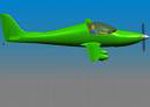 The Coming Electric Airplane RevolutionRandall Fishman’s public AirVenture Oshkosh 2008 demonstration (see AVweb and Kitplanes video interview, here) of his virtually silent, nearly vibration-free and fillup-less single place ElectraFlyer-C (capable of flying for an hour and a half on 75 cents worth of lithium-polymer battery power) is just the tip of the iceberg. Fishman is seeking partnership with a suitable airframe manufacturer of an existing light efficient two-place aircraft in which he can install a larger electric motor. Meanwhile, Greg Cole (previously chief engineer of research and development at Lancair), who recently created the 36-foot span, 155-pound carbon composite Sparrowhawk sailplane (soon available for about $73,000 with electric power), is working toward a two-place “Goshawk” electric-powered sport aircraft that aims to cruise at up to 115 knots on 21 (electric) horsepower for about an hour. Cole and Fishman are both American pioneers funding their own projects, but overseas, the European Union has contributed about 20 percent of a reported $2.3 million applied to the development of Slovenian aircraft manufacturer Pipistrel’s two-place side-by-side self-launch electric motorglider.
The Coming Electric Airplane RevolutionRandall Fishman’s public AirVenture Oshkosh 2008 demonstration (see AVweb and Kitplanes video interview, here) of his virtually silent, nearly vibration-free and fillup-less single place ElectraFlyer-C (capable of flying for an hour and a half on 75 cents worth of lithium-polymer battery power) is just the tip of the iceberg. Fishman is seeking partnership with a suitable airframe manufacturer of an existing light efficient two-place aircraft in which he can install a larger electric motor. Meanwhile, Greg Cole (previously chief engineer of research and development at Lancair), who recently created the 36-foot span, 155-pound carbon composite Sparrowhawk sailplane (soon available for about $73,000 with electric power), is working toward a two-place “Goshawk” electric-powered sport aircraft that aims to cruise at up to 115 knots on 21 (electric) horsepower for about an hour. Cole and Fishman are both American pioneers funding their own projects, but overseas, the European Union has contributed about 20 percent of a reported $2.3 million applied to the development of Slovenian aircraft manufacturer Pipistrel’s two-place side-by-side self-launch electric motorglider.
The $133,000 Taurus Electro is on pace to begin customer deliveries later this year and though the Electro carries its powerplant on a fuselage mounted retracting arm, Pipistrel has announced an electric motor “constructed for continuous operation.” For all these efforts one universal unknown remains: how the FAA’s Light Sport Aircraft rules will adapt to address electric propulsion.
Current FAA regulations do not account for aircraft with electric motors in the LSA category, but the EAA in late April petitioned the FAA to change that. EAA filed a request with the FAA for regulatory exemptions that “would allow the use of electric motors in ultralight and light sport aircraft,” according to EAA. Fishman and Cole are both proceeding under the funding constraints of their own wallets, and it seems likely Pipistrel will beat them to the punch, but it remains to be seen whether Pipistrel’s product will appeal to buyers outside of the sailplane market. For all comers, yet-to-be-drafted regulations are among the many potential obstacles. As those regulations and technology take their course, the rest of us will be watching.


































